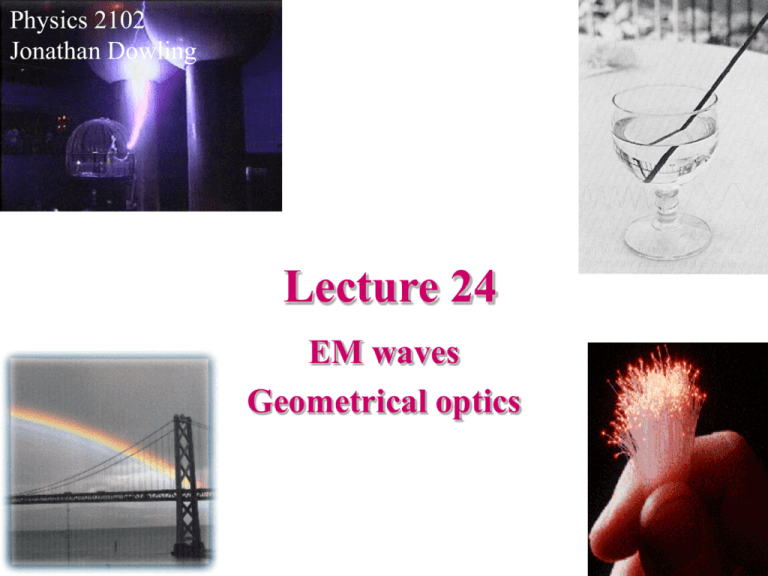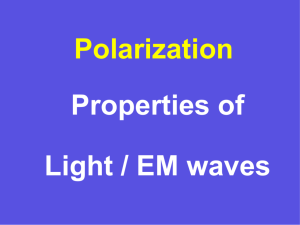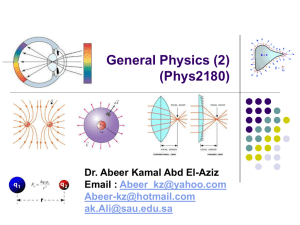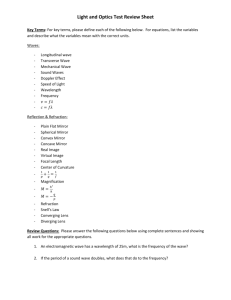PPT - LSU Physics & Astronomy
advertisement

Physics 2102 Jonathan Dowling Lecture 24 EM waves Geometrical optics EM spherical waves The intensity of a wave is power per unit area. If one has a source that emits isotropically (equally in all directions) the power emitted by the source pierces a larger and larger sphere as the wave travels outwards. I Ps 4r 2 So the power per unit area decreases as the inverse of distance squared. Example A radio station transmits a 10 kW signal at a frequency of 100 MHz. (We will assume it radiates as a point source). At a distance of 1km from the antenna, find (a) the amplitude of the electric and magnetic field strengths, and (b) the energy incident normally on a square plate of side 10cm in 5min. Ps 10kW 2 I 0 . 8 mW / m 4r 2 4 (1km) 2 1 2 I Em Em 2c I 0.775V / m 2c Bm Em / c 2.58 nT Received energy: P U / t S U SAt 2.4 mJ A A Radiation Pressure Waves not only carry energy but also momentum. The effect is very small (we don’t ordinarily feel pressure from light). If light is completely absorbed during an interval t, the momentum transferred is given by p u and twice as much if reflected. c A p Newton’s law: F t I Now, supposing one has a wave that hits a surface of area A (perpendicularly), the amount of energy transferred to that surface in time t will be IA IAt F U IAt therefore p c c Radiation pressure: I 2I pr (total absorption), pr (total reflection) c c EM waves: polarization Radio transmitter: If the dipole antenna is vertical, so will be the electric fields. The magnetic field will be horizontal. The radio wave generated is said to be “polarized”. In general light sources produce “unpolarized waves”emitted by atomic motions in random directions. EM waves: polarization Completely unpolarized light will have equal components in horizontal and vertical directions. Therefore running the light through a polarizer will cut the intensity in half: I=I0/2 When polarized light hits a polarizing sheet, only the component of the field aligned with the sheet will get through. E y E cos( And therefore: I I 0 cos 2 Example Initially unpolarized light of intensity I0 is sent into a system of three polarizers as shown. Wghat fraction of the initial intensity emerges from the system? What is the polarization of the exiting light? • Through the first polarizer: unpolarized to polarized, so I1=½I0. • Into the second polarizer, the light is now vertically polarized. Then, I2=I1cos26o = 1/4 I1 =1/8 I0. • Now the light is again polarized, but at 60o. The last polarizer is horizontal, so I3=I2cos23o 3/4 I23/32 I0=0.094 I0. • The exiting light is horizontally polarized, and has 9% of the original amplitude. Reflection and refraction When light finds a surface separating two media (air and water, for example), a beam gets reflected and another gets refracted (transmitted). Law of reflection: the angle of incidence 1 equals the angle of reflection ’1. Law of refraction: n2 sin 2 n1 sin 1 Snell’s law. n is the index of refraction of the medium. In vacuum, n=1. In air, n~1. In all other media, n>1. Example Water has n=1.33. How much does a beam incident at 45o refracts? n2 sin 2= n1 sin 1 sin 2= (n1 /n2) sin 1 =(1/1.33) sin 45o =0.0098 2= 32o Image of the object Actual object Actual light ray Light ray the brain imagines (as if in air) Example: an optical illusion The index of refraction decreases with temperature: the light gets refracted and ends up bending upwards. We seem to see water on the road, but in fact we are looking at the sky! Chromatic dispersion The index of refraction depends on the wavelength (color) of the light. Total internal reflection From glass to air, the law of refraction uses n2<n1, so 2>1: it may reach 90o or more: the ray is “reflected” instead of “refracted”. 2 n2 sin 2= n1 sin 1 n2~1 1 n1 For glass (fused quartz) n=1.46, and the critical angle is 43o: optical fibers! Polarization by reflection Different polarization of light get reflected and refracted with different amplitudes (“birefringence”). At one particular angle, the parallel polarization is NOT reflected at all! This is the “Brewster angle” B, and B+ r=90o. n1 sin n2 sin( 90o ) n2 cos tan n2 n1 Geometrical Optics • “Geometrical” optics: light rays (“particles”) that travel in straight lines. • “Physical” optics: electromagnetic waves which have amplitude and phase that can change. Light is BOTH a particle (photon) and a wave: wave-particle duality. Plane mirrors Light rays reflect on a plane mirror, and produce a virtual image behind the mirror. What’s a virtual image? It means the light rays are NOT coming from a real point, they only seem to come from there to our eyes and brain. object image i= p for a plane mirror Spherical mirrors • Focal point is at half the curvatuire radius: f= r/2 . •Rays parallel to the axis, reflect through the focal point. • Rays hitting the mirror after going to the focal point, emerge parallel. • Rays going through the center of curvature, reflect back on themselves. Concave mirrors: r > 0 Convex mirrors: r < 0 Images from spherical mirrors Consider an object placed between the focal point and the mirror. It will produce a virtual image behind the mirror. When the object is at the focal point the image is produced at infinity. If the object is beyond the focal point, a real image forms at a distance i from the mirror. 1 1 1 p i f i m p Check the signs!! lateral magnification Example An object 2cm high is located 10cm from a convex mirror with a radius of curvature of 10cm. Locate the image, and find its height. Focal length: f= r/2= 10cm/2= 5cm. Image position: 1/i=1/f-1/p= -1/5cm –1/10cm= -3/10cm i= - 10/3cm = -3.33 cm: the image is virtual. Magnification: m= -i/p= - (-3.33cm)/(10cm)=0.33 (smaller). If the object image is 2cm, the image height is 0.33 x 2cm=0.67 cm. How important is it to know where the image is? A star seen with a ground telescope and with “old” Hubble Hubble mirror: The central region of the mirror was flatter than it should be - by just one-fiftieth of the width of a human hair. This is equivalent to only four wavelengths of visible light, but it was enough. One insider said that the Hubble mirror was "very accurate, very accurately the wrong shape". The same star seen with the “new” Hubble Before and after...




